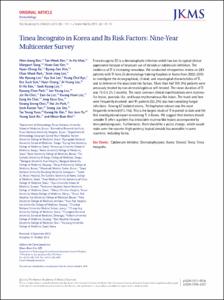Tinea Incognito in Korea and Its Risk Factors: Nine-Year Multicenter Survey
- Keimyung Author(s)
- Lee, Kyu Suk
- Department
- Dept. of Dermatology (피부과학)
- Journal Title
- Journal of Korean Medical Science
- Issued Date
- 2013
- Volume
- 28
- Issue
- 1
- Keyword
- Calcineurin Inhibitor; Dermatophytoses; Korea; Steroid; Tinea; Tinea Incognito
- Abstract
- Tinea incognito (TI) is a dermatophytic infection which has lost its typical clinical
appearance because of improper use of steroids or calcineurin inhibitors. The
incidence of TI is increasing nowadays. We conducted retrospective review on 283
patients with TI from 25 dermatology training hospitals in Korea from 2002–2010
to investigate the demographical, clinical, and mycological characteristics of TI,
and to determine the associated risk factors. More than half (59.3%) patients were
previously treated by non-dermatologists or self-treated. The mean duration of TI
was 15.0 ± 25.3 months. The most common clinical manifestations were eczemalike
lesion, psoriasis-like, and lupus erythematosus-like lesion. The trunk and face
were frequently involved, and 91 patients (32.2%) also had coexisting fungal
infections. Among 67 isolated strains, Trichophyton rubrum was the most
frequently detected (73.1%). This is the largest study of TI reported to date and the
first investigational report concerning TI in Korea. We suggest that doctors should
consider TI when a patient has intractable eczema-like lesions accompanied by
tinea pedis/unguium. Furthermore, there should be a policy change, which would
make over-the-counter high-potency topical steroids less accessible in some
countries, including Korea.
- Keimyung Author(s)(Kor)
- 이규석
- Publisher
- School of Medicine
- Citation
- Won-Jeong Kim et al. (2013). Tinea Incognito in Korea and Its Risk Factors: Nine-Year Multicenter Survey. Journal of Korean Medical Science, 28(1), 145–151. doi: 10.3346/jkms.2013.28.1.145
- Type
- Article
- ISSN
- 1011-8934
- Appears in Collections:
- 1. School of Medicine (의과대학) > Dept. of Dermatology (피부과학)
- 파일 목록
-
-
Download
 oak-aaa-2541.pdf
기타 데이터 / 1.78 MB / Adobe PDF
oak-aaa-2541.pdf
기타 데이터 / 1.78 MB / Adobe PDF
-
Items in Repository are protected by copyright, with all rights reserved, unless otherwise indicated.